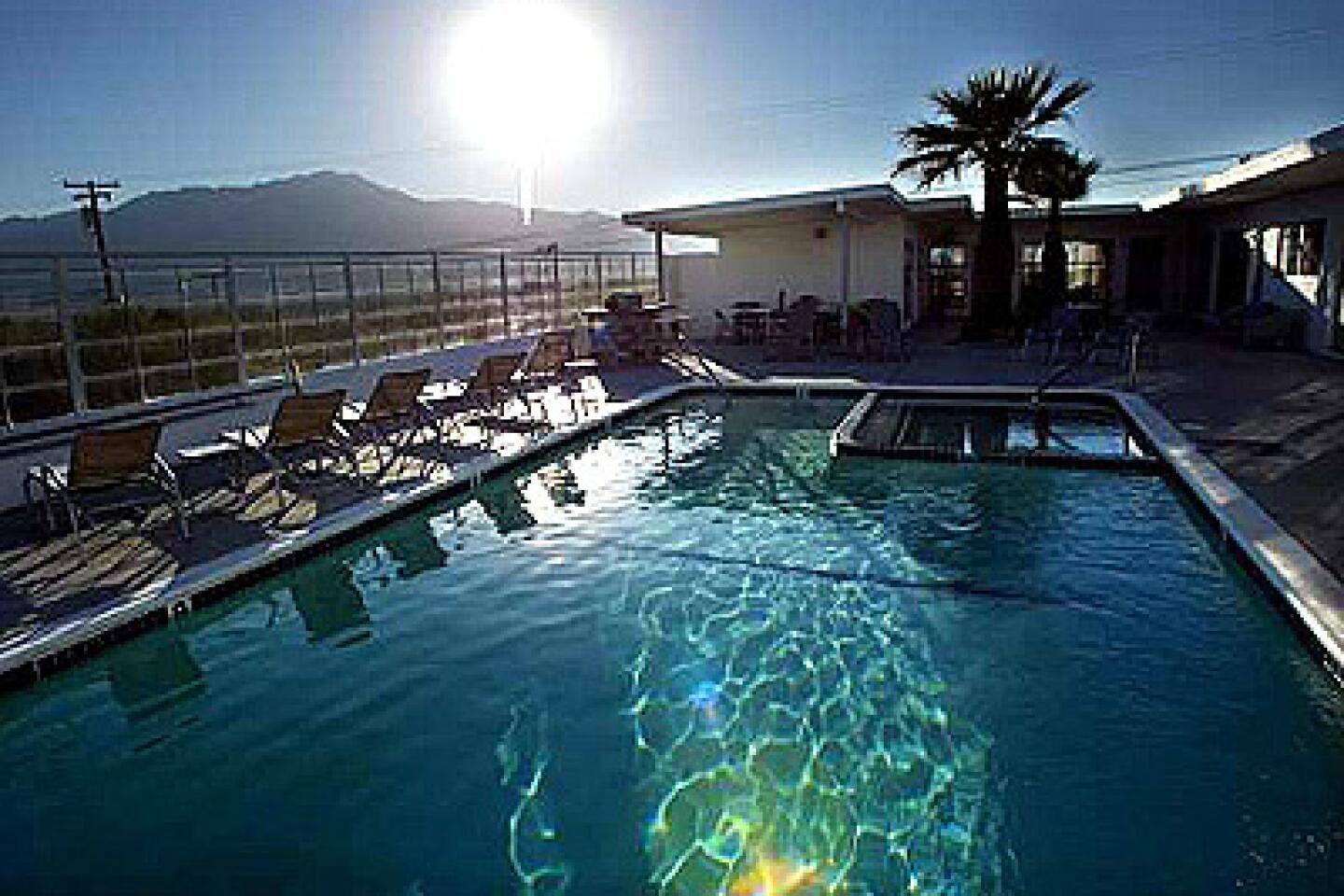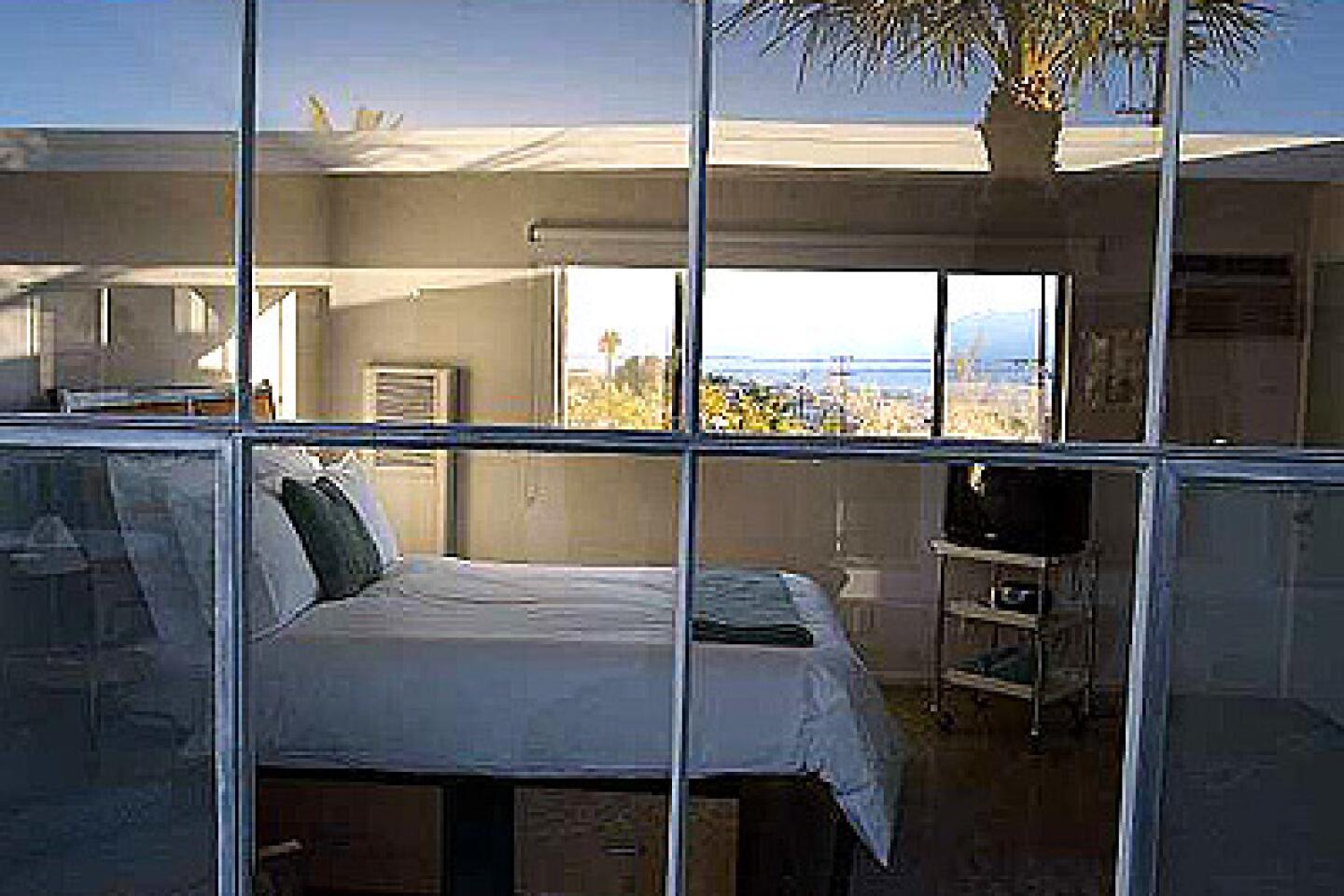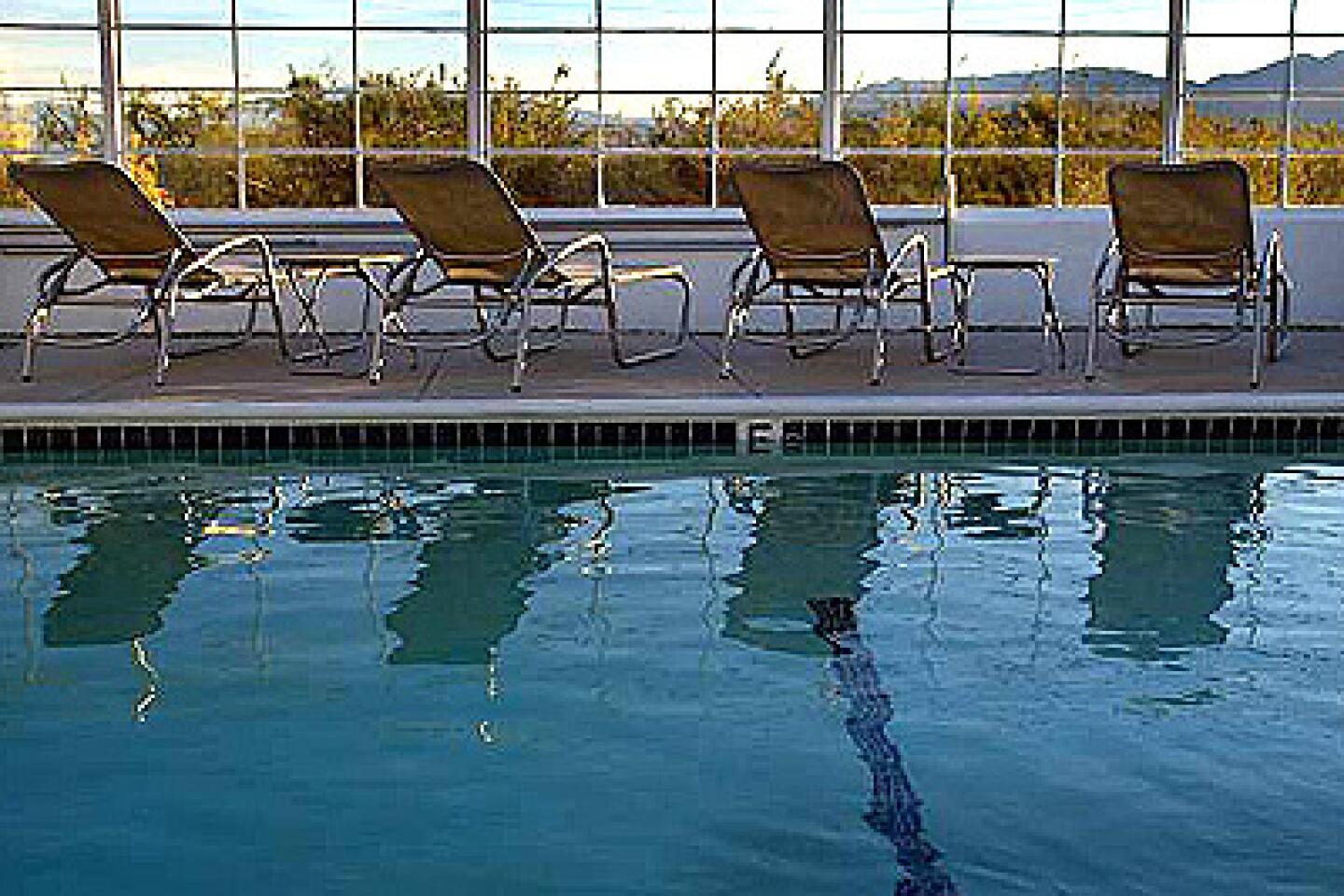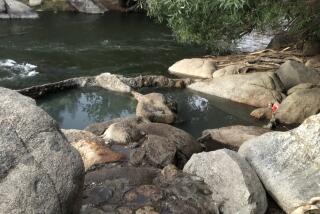Seaweed in Desert Hot Springs’ sand
“I had Splendor,” purred my buddy Steve, looking pleasantly woozy after his seaweed-wrap spa treatment.
“Sure looks it,” I said.
“No,” he corrected. “Splendor was the masseuse’s name.”
Those who know the Coachella Valley might be surprised to see “Desert Hot Springs” and “splendor” on the same page. Residents of Palm Springs and its tony neighbors have long viewed this city 20 minutes to the north as an embarrassing cousin. If Palm Springs is women in heels buying Brie at Jensen’s Finest Foods, Desert Hot Springs is women in fuzzy bedroom slippers buying Chips Ahoy at Stater Bros.
But Desert Hot Springs, population 15,000, has one thing much of the valley doesn’t: natural hot springs. Steve and I travel frequently on business, and earlier this month we wanted a place to catch up and do nothing important. We didn’t expect a weekend quite so convivial, subtly spiritual and stylish.
Although many lodgings here are past their prime, some tiny properties have been renovated with striking results. We considered Hope Springs, where 1950s design is matched with Eames and Saarinen furniture, desert flora and three mineral pools. But rooms here ($150 to $175) have only one bed; Steve and I are close but not that close. We also considered Two Bunch Palms ($175 to $485 weekends) and Miracle Manor ($189 to $219 weekends), two of the town’s best-known retreats.
We ended up at Sagewater Spa, which opened last year on a hillside overlooking the valley. This minimalist seven-room place is full of right angles, white-on-white décor with touches of sage, high beds with Frette linens, in-room kitchens and polished concrete floors. Weekend rates start at $185 a night. We snagged Sagewater’s lone two-bed room, which was more spacious and had an expanded kitchen, for $250. That’s almost as much as luxury resorts down in the valley charge in peak season, but Sagewater turned out to be a real getaway -- smaller, less crowded, more personal.
Cristina Pestana, the proprietor, had been “honey”-ing me in her lilting Brazilian accent during phone calls before our arrival, and our welcome was just as warm. We were presented with a small, aromatic loaf of coffee cake made by Rhoni Epstein, Cristina’s partner, then shown to our room. Inside was a CD player, TV and, blessedly, no phone (although each room has a DSL connection).
Steve wanted to pounce on the coffee cake, but discipline prevailed. (“That’s breakfast food!” I snipped.) We drove a few minutes to Casa Blanca, a comfy Mexican cantina. Pacífico beer in iced mugs went perfectly with the restaurant’s chunky fresh guacamole and chipotle salsa. Combination plates were huge and delicious: carne asada sharing the plate with sautéed shrimp, onion and bell pepper for me, enchiladas for Steve.
After dinner we stopped at a supermarket (scene of the fuzzy-slipper sightings) for fruit and finally, under cover of darkness, dipped into Sagewater’s mineral pool-within-a-pool, a 105-degree hot tub inside a 90-degree swimming pool. We stargazed with the other guests -- Hollywood types and a congenial couple of returning Sagewater guests from Orange County. A cynic might have sneered at a hot tub full of city slickers trying to locate Polaris, but everyone was mellow and accepting. After Cristina turned off the lights outside each room, all went quiet, and the stars seemed as bright as could be.
Splendor in many forms
In such a minimalist space, one has little choice but to chill, and chill we did the next morning: lazing in the pool, lazing out of the pool, snoozing, eating coffee cake (it lived up to high expectations), sipping cucumber water, making new friends, blissing out on medieval polyphonic music.
So it went until Steve looked up from his magazine and said, “Let’s go to Joshua Tree.” Before the 45-minute drive, we filled water bottles from the tap. An aquifer yields the town’s drinking water, which has won national taste tests (and really is delicious).
Near the entrance to the national park we stopped at Crossroads Cafe, where rough-hewn wood walls and folk-art-painted trim felt right out of the ‘60s. Our lunch, though, was up to date: The Grilled Coyote sandwich -- chicken breast with portabello mushroom, apple-wood smoked bacon, Jack and cheddar -- was enjoyably messy and came with a soup of artichoke hearts, black olives and tomato.
The landscape that followed was just as pleasing. If there’s such a thing as a Joshua tree plantation, it probably would look like our route through the park. The stubby-limbed trees reached all the way to distant rock outcroppings scaled by climbers. On a short hike in Hidden Valley, we paused to appreciate the silence. Steve termed the scenery “God’s art,” a sentiment echoed in a Robinson Jeffers poem on a plaque along the trail, praising “the divine beauty of the universe.”
Soon it was time for Splendor of the human kind, and we returned to Sagewater for Steve’s spa treatment. If you think spa visits sound girlie, know that a 2002 International Spa Assn. survey showed that 24% of the clientele at U.S. spas is male, and the percentage is growing.
While Steve was being seaweed-wrapped, I walked 50 yards to tour Cabot’s Pueblo Museum. It’s named after Cabot Yerxa (born 1883), a colorful adventurer, tradesman and descendant of the Boston Cabots.
Yerxa homesteaded here in 1913. For a year he and his beloved burro, Merry Christmas, rode out of town to fetch drinking water until an American Indian told him about local springs. Yerxa drilled for water and, atop hot and cold aquifers, built a pueblo-style home that looks like an orderly pile of boxes. When he died in 1965, the rooms totaled 35.
Back at the Sagewater pool, as sunset tinted the sky pink, Cristina and Rhoni served caipirinhas -- sweet, juiced with lime and very Brazilian. The pool was their parlor, they were our hostesses and we were a party. Guests shared snacks and drinks and would have barbecued dinner together had not the desert winds kicked up.
So some of us drove a few minutes to Capri, a steakhouse that reminded the Northeasterners among us of the Italian places we had grown up with. Entrees come with soup and salad plus a side of pasta. Even if I didn’t love the overly sweet Marsala sauce on my veal, everyone else seemed to enjoy their dinners, especially the steak.
Given the huge meal, no wonder we were asleep the moment we hit the beds, dreaming of mineral baths, massages, great winds and the universe. That put us in the mood the next morning to visit the Integratron, on a swatch of desert in Landers about 45 minutes north.
The Integratron was built by George Van Tassel (1910-1978), a test pilot and inventor who claimed to have been visited by beings from Venus -- not the planet, but some other Venus. (We didn’t understand either.) He built this dome, 38 feet high and 50 feet in diameter, as a “high voltage electrostatic generator that would supply a broad range of frequencies to recharge the cell structure.” In other words, electroshock rejuvenation and, he hoped, time travel.
The Integratron never was operational. Today it’s a museum and a venue for “sound baths” under its acoustically marvelous dome. Group sound baths, $7 a person, are held the first three Sundays of the month.
A docent used dowels to generate soothing sounds from seven crystal bowls ranging from as small as a grapefruit to as large as a barrel. Each sound is said to resonate with a specific body part, and the effects supposedly fall somewhere between cosmic bliss and cranking your favorite song on the car radio. Some visitors, the docent said, feel as if they’re being massaged. I didn’t experience those effects, although I enjoyed being lost in the moment. Steve’s reaction was more intense: cold sweats and feelings of being out of space and time.
Proof, once again, that the desert offers many chances to get away.
Santa Monica-based freelance writer Andrew Bender is the author of several Lonely Planet guidebooks.
More to Read
Sign up for The Wild
We’ll help you find the best places to hike, bike and run, as well as the perfect silent spots for meditation and yoga.
You may occasionally receive promotional content from the Los Angeles Times.










